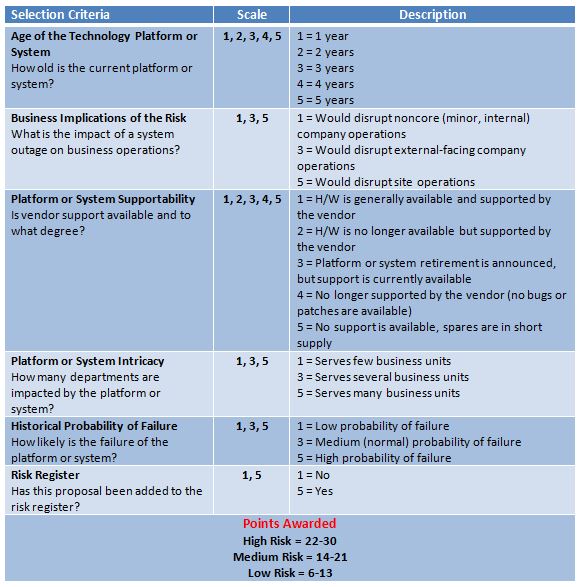Introduction
The company to be discussed in this article is one of the largest oil and gas producers in the world. In this particular case we will examine the portfolio management system designed by one of the organization's regional IT departments.
The situation at the company was such that all the major IT projects were undertaken by the company headquarters, while the local IT departments were responsible mainly for servicing the needs of the offshore platforms. The executives of the regional department felt under constant pressure as many of the projects proposed by them, were denied by the headquarters an, yet, they remained responsible for the safety, reliability and security of all the offshore operations.
As a result they felt that creation of a portfolio scoring model would help them with (a) prioritization of their project proposals and (b) demonstration of the importance of their initiatives to the executive managers at the headquarters.
Strategy
The overall company strategy has been developed at the organizational headquarters and consisted of approximately ten strategic initiatives. However the strategies directly related to the regional offices were:
- Safety and reliability of all the operations
- Fiscal responsibility
- Simpler and more standardized procedures
The Scoring Model
The scoring model created as a result of a one-day facilitated project portfolio management session is presented in Table 1.
Table 1
As can been seen it was a very unusual model when compared to other scoring matrices described in the book. One may call it a purely risk-based approach to project prioritization.
The model included the following variables:
- Age of the Technology Platform or System - the project can be awarded between 1 and 5 points based on the age of the system
- Business Implications of the Risk - the proposal received 1 point if the system failure would disrupt noncore (minor, internal) company operations, 3 points if it would disrupt external-facing company operations, and 5 points for the potential disruption of the site (platform) operations
- Platform or System Supportability - the initiative would receive between 1 and 5 points depending on the degree of vendor support
- Platform or System Intricacy - the project could be awarded either 1, 3 or 5 points for the system serving either few, several or many business units
- Historical Probability of Failure - again, the proposal could be awarded either 1, 3 or 5 points for low, medium or high historical probability of failure of such systems in the past
- Risk Register - finally the project received either 1 or 5 points depending on whether it has been added to the company-wide risk register.
Therefore a project proposal could receive between six and thirty points allowing for a very quick prioritization of the initiatives. In addition the executives decided to designate the following ranges for the points awarded:
- High Risk = 22-30 points - a "Must Do" project category; projects that must be initiated immediately
- Medium Risk = 14-21 points - a "Should Do" project category; projects that should be approved or in special circumstances deferred maximum by a year
- Low Risk = 6-13 points - a "Nice to Do" project category; projects that can be postponed by 2-3 years and revisited by that time.
Finally, the scoring model developed did not have a "joker" project category simply due to the fact that the regional managers did not have the authority to unilaterally approve and initiate projects.
Portfolio Balance
No portfolio balance requirements were imposed on the model in question, mainly due to the fact that all of the projects run by the local IT department would fall into low-risk, low reward category.
Strategic Alignment
Since this particular risk-based selection and prioritization model had direct linkage to the safety and fiscal responsibility initiatives outlined in the strategy section, and due to the fact that all of the projects would have fallen into the "maintenance" project category, the executives decided not to designate any special buckets.
It was mentioned at the end of the exercise, that once several years of data is accumulated it might be interesting to examine the project breakdown by the platforms.
About the Author
Jamal Moustafaev, MBA, PMP – president and founder of Thinktank Consulting is an internationally acclaimed expert and speaker in the areas of project/portfolio management, scope definition, process improvement and corporate training. Jamal Moustafaev has done work for private-sector companies and government organizations in Canada, US, Asia, Europe and Middle East. Read Jamal’s Blog @ www.thinktankconsulting.ca
- Please follow me on Twitter:
- Like our page on Facebook:
- Connect with me on LinkedIn:
- Subscribe to my RSS feed:
Jamal is an author of two very popular books: Delivering Exceptional Project Results: A Practical Guide to Project Selection, Scoping, Estimation and Management and Project Scope Management: A Practical Guide to Requirements for Engineering, Product, Construction, IT and Enterprise Projects.

